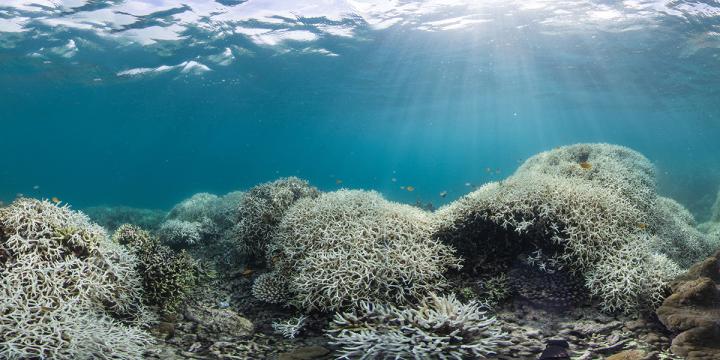
Credit: The Ocean Agency / XL Catlin Seaview Survey / Richard Vevers
DURHAM, N.C. – Local conservation can boost the climate resilience of coastal ecosystems, species and cities and buy them precious time in their fight against sea-level rise, ocean acidification and warming temperatures, a new paper by scientists at Duke University and Fudan University suggests.
The peer-reviewed paper, published Oct. 7 in Current Biology, comes at a time when scientists are divided on whether to continue investing in local efforts to protect threatened places and populations or shift much of that investment toward global efforts to reduce fossil fuel emissions.
“The answer is, you need both,” said Brian R. Silliman, Rachel Carson Associate Professor of Marine Conservation Biology at Duke’s Nicholas School of the Environment.
“Our analysis of local conservation efforts shows that in all but extreme situations, these interventions significantly buffer the impacts of climate change and can buy our sinking cities and bleaching corals time to adapt until the beneficial impacts of global emissions reductions kick in,” Silliman said.
In the Florida Keys, for instance, local efforts to cull populations of coral-eating snails reduced thermal bleaching on corals by 40% compared to bleaching on non-treated corals during a three-month spike in water temperatures in 2014. It also promoted faster recoveries.
In Chesapeake Bay, seagrass beds that were wiped out by warming waters and heavy pollution are now reappearing, largely due to local efforts to cut nutrient pollution flowing into the bay.
In Shanghai, where the weight of thousands of high-rises and the depletion of groundwater aquifers causes the ground to sink further each year as the sea is rising, efforts to pump water back into wells and place tighter controls on groundwater use have slowed the subsidence though, and given city officials time to enact other protective measures.
“A common thread in many of the most successful scenarios we reviewed is that the local actions increased climate resilience by removing or reducing human-related stresses that were compounding climate stresses and increasing a species’ or site’s vulnerability,” said Qiang He, professor of coastal ecology at Fudan University in Shanghai, China, who co-authored the new paper with Silliman.
Understanding how human and climate stresses interact is critical for predicting when, where or if local interventions are likely to be effective and what their limits might be, so we can target our efforts accordingly and begin adaptive measures while there is still time, He said.
This is especially true in areas with high human population densities.
One of the most telling examples of this is the tragedy now facing the Indonesian capital of Jakarta, where massive groundwater withdrawal and the weight of 10 million people and their buildings is causing the city to sink by roughly 25 centimeters a year, He noted. By 2050, 95% of the city will be submerged as a result of the compounding effects of sea-level rise and human actions.
“Because Jakarta – unlike Shanghai – did not decrease its human impacts through local conservation or adaptation, the government’s only recourse now is to move the entire city to a new, higher location on the island of Borneo,” Silliman said.
“Unfortunately, other massive migrations of cities inland will become more and more common in coming decades, but we can reduce their number and how quickly they have to happen if we take dual action now on the local and global fronts,” Silliman said. “For certain, this is no time to scale back on local conservation. We need to increase our investment at all scales.”
###
Silliman and He’s paper, which appears in Current Biology‘s “Anthropocene” special edition, was funded by the National Natural Science Foundation of China (grant #31870414), the U.S. National Science Foundation (grant #1445834 and the Lenfest Ocean Program. Additional support came through a Distinguished Fulbright Chair to Silliman from the Commonwealth Scientific and Industrial Research Organization in Queensland, Australia.
Prior to joining the faculty at Fudan, Qiang He was a postdoctoral researcher in Silliman’s lab at Duke.
CITATION: “Climate Change, Human Impacts, and Coastal Ecosystems in the Anthropocene,” Qiang He and Brian R. Silliman; Current Biology, Oct. 7, 2019. DOI: 10.1016/j.cub.2019.08.042
Media Contact
Tim Lucas
[email protected]
919-613-8084
Original Source
https:/
Related Journal Article
http://dx.




